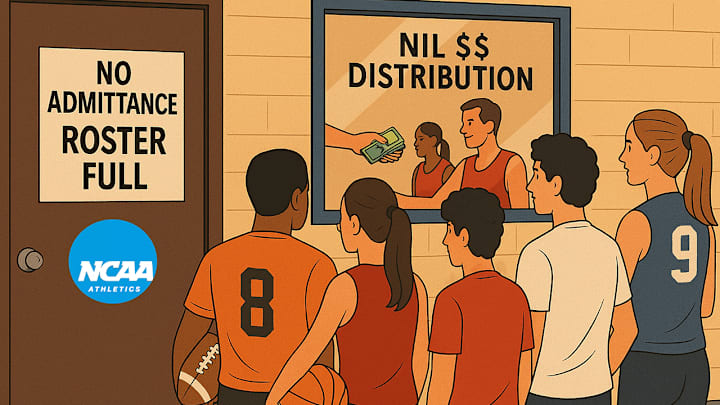NCAA Roster Caps Could Squeeze Out High School Recruits Under NIL Settlement

What had been anticipated for many months, became a reality last Friday when U.S. District Judge Claudia Wilken, in Oakland, California, granted final approval of the settlement of three antitrust class action lawsuits brought against the NCAA and each of, what were, its Power 5 conferences (now down to four). The settlement created a $2.8 billion damages pool to make Name, Image and Likeness (NIL) payments to former college athletes, while providing the framework for schools to directly pay current and future college athletes.
In addition to the funds set aside to pay former college athletes, who competed between 2016 and 2024, over the next 10 years, the settlement allows schools to share as much as $20.5 million of their athletic revenues with their student athletes during the upcoming 2025-26 academic year. The revenue sharing cap will grow by 4% each year of the 10-year agreement. In addition, college programs will no longer be limited in how many scholarships they can offer to the athletes on their rosters. If a school so chooses, every athlete on every team it fields, can be offered a full scholarship.
On the flip side, roster sizes have been cut for all but a handful of sports, in an effort, theoretically, to control costs. Discussions around roster limits were the biggest hold up in securing final approval for the settlement, which was agreed to by the lawyers for the plaintiffs and the NCAA in 2024.
'Designated Student Athletes' Will Not Count Against Roster Limits
One of the reasons the approval of the settlement, which was expected in early April, was delayed until June was to allow the parties to resolve concerns over the proposed cuts to roster sizes.
Estimates on the number of rosters cuts called for under the settlement range between 5,000 and 13,000 across the 43 sanctioned NCAA sports. For example, football programs will be limited to 105 players. Some football programs have carried as many as 180 players with the average roster size being around 125. Men's basketball has been cut from 17 players to 15, baseball rosters decreased from an average size of 41 to 34. Some sports, mostly on the women's side, increased.
Arguments seeking to protect the roster spots of student-athletes already on college teams resonated with Judge Wilken. During an April 7th hearing in which various parties were allowed to voice objections to the settlement, the issues revolving around roster limits were the ones which carried weight.
In an April 23rd ruling, Judge Wilken stated, "Because the settlement agreement is not fair and reasonable to the significant number of class members whose roster spots will be or have been taken away because of the immediate implementation of the settlement agreement, the Court cannot approve the settlement agreement in its current form.
"The Court will delay denial of final approval to permit the parties to attempt to modify the settlement agreement so that members of the Injunctive Relief Settlement Class will not be harmed by the immediate implementation of the roster limits provisions. One way of achieving that could be to modify the settlement agreement to ensure that no members of the Injunctive Relief Settlement Class who have or had a roster spot will lose it as a result of the immediate implementation of the settlement agreement. Limits could be accomplished gradually by attrition. There may be other ways of mitigating the harm to members of the Injunctive Relief Settlement Class. A new round of notices to class members may not be required if the parties modify the settlement agreement in a manner that does not adversely affect class members."
The agreement the parties reached, which ultimately cleared the way for Judge Wilken's final approval of the settlement, allowed for current college athletes who would not make the cut under the new roster limits, to be classified as "Designated Student-Athletes (DSA)," which, in theory, protects their place on a team's roster, as an exemption. Athletes with the DSA status will be allowed to remain on their teams and will not count against their program's roster limit. When all DSAs exhaust their college athletic eligibility, the team will have to fully comply with its mandated roster limit.
"The individual universities have 30 days, and if my math is right, until July 6, to create a list of those designated student athletes from the 2024-25 school year and provide that to class council and their conferences," said Doug DePeppe, an attorney in the Denver office of the Buckalter law firm, which represented several objectors to the settlement, based on the original roster limit provisions. "They have to use good faith and identify those athletes."
Proposed NCAA Settlement Threatens Non-Revenue Sports: Roster Caps Jeopardize 25,000 D1 Roster Spots
Graduating High School Seniors Can Also Be Granted DSA Status
Graduating high school student athletes in the Class of 2025, who were being recruited and/or offered scholarships or walk-on opportunities, are also eligible for the Designated Student Athlete status.
Those who receive it, most likely owe that opportunity to Gracelyn Laudermilch, a cross country and track star at Northeast Bradford High School in Rome, Pennsylvania.
Laudermilch was set to commit to her dream college. She was not guaranteed a scholarship, but she was assured of a roster spot with an opportunity to earn a scholarship if she could meet certain performance levels, according to a May 14 story by Front Office Sports. When it came time to make her formal commitment, however, her future coach gave her some tough news.
"You cannot commit. … I just found out four hours earlier that I have to cut half of my team,” Laudermilch told FOS of her conversation with the coach.
Laudermilch was in a bind, as she had passed on all of her other Division I suitors. After news accounts about the settlement case, she learned she could apply to be an objector, for which, to her astonishment, she was selected. She flew to California to testify before Judge Wilken and, according to many observers, stole the show.
In her passionate testimony, Laudermilch said, "I believe this settlement is unfair. The roster limits destory the hard work and dreams of thousands of student athletes like me all over the nation. By God's grace, I have been able to reach many of my desired stepping stones: I am a 4x state medalist and an All-American. I hold numerous school records. As a junior, I had met the walk-on and scholarship standards of several D1 schools. As I began my senior year, I was on course to attend my dream college. My 14-year old self would have been so proud.
"But then came the House vs. NCAA case, and all of my plans came to a halt. I had been in contact with five Division I schools and one NAIA school. I went on three college visits and carefully made my decision. My other offer deadlines came. I politely declined them. My dreams, prayers and hopes were becoming my reality. I was so excited to have the opportunity to train in impressive facilities under outstanding coaches and with amazing girls who have the same high goals. I made the call to commit. It was October 30, 2024 at 4 pm. The coach compassionately told me that mere hours earlier she had been informed that their university was opting into the settlement. I hung up the phone and cried."
According to DePeppe, college coaches will have to make a list of current high school senior athletes which they recruited and submit them for approval on the DSA list.
"Certainly, those who accepted a scholarship will be granted the DSA status," said DePeppe. "If they were actively being recruited or offered walk-on opportunities, the universities will be required to use good faith to identify them, but the coaches will have some discretion there."
Unfortunately, no such protections were offered to athletes in the Class of 2026 or beyond. Those student-athletes will experience the full impact the limited Division I opportunities. Those athletes will be forced to move their aspirations to the Division II or III and JUCO levels, possibly taking spots from other athletes who may have found their place at those levels.
Colleges Begin Preparations to Identify Their Designated Student Athletes
In a communication to Kansas University student-athletes, issued on June 7 by Kansas Athletic Director Travis Goff and obtain by High School On SI, Goff explained the impact of the new roster limits.
"With the settlement, most sports will see their rosters reduced, though a couple may see minor increases," wrote Goff. "There will now be 'designated student-athletes.' What this means is that student-athletes that would have been cut from the team due to roster limits will receive special designated status that allows them to not count against any roster limit, whether at KU or another university.
"Over the next several weeks we will be working with conference officials on this designation process and will then communicate with those impacted."
The College Sports Commission (CSC), which was established immediately after the settlement was announced, to insure enforcement and compliance with the provisions of the settlement, defines a Designated Student Athlete as follows:
Any student-athlete who a school attests was or would have been removed from the school’s 2025-26 roster due to the implementation of roster limits who was either:
- certified as eligible for practice or competition at the school (i.e., on a roster whether as a recruited or walk-on player), during the 2024-25 academic year, prior to April 7, 2025, including student-athletes who transferred, or
- a student-athlete initial enrollee at a Division I school for the 2025-26 academic year who, prior to April 7, 2025, was recruited to be, or was assured by an institutional staff member they would be, on the school’s roster for the 2025-26 academic year.
College Opportunities Were Already Shrinking for High School Athletes
There will always be college opportunities for elite high school student-athletes, especially those of the 4- and 5-star variety in football as well as men's and women's basketball. But the dawn of the NIL era, which has reached warp speed in the last 2-3 years, had already begun to make being recruited a difficult task for those athletes not as highly regarded as those in the top trier.
The relaxing of transfer rules and the flood of NIL money into big time college athletics, which essential has made every athlete a free agent each and every year of his or her college eligibility, has led to an explosion in the use of the transfer portal.
No longer can a college coach count on a player remaining and developing within a program. If an athlete does not receive enough playing time or believes more NIL money awaits at another program, they can up and leave. Coaches are often faced with fielding an entirely new roster from one season to the next. This has led coaches to hedge on offers to high school athletes not in the top tier, or preferring to recruit a transfer with proven college experience.
